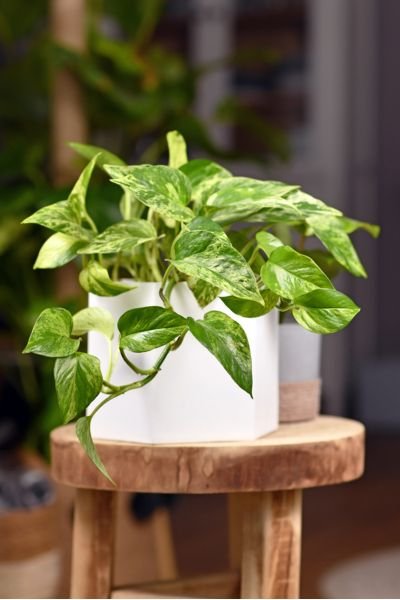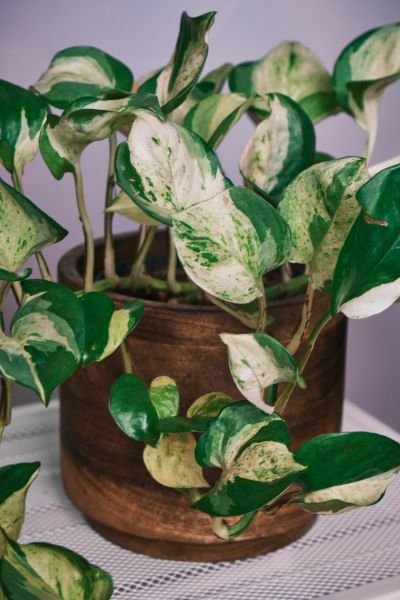Harlequin Pothos (Epipremnum aureum ‘Harlequin’) is a captivating and unique plant that has gained popularity among indoor garden enthusiasts. However, this remarkable variety is often shrouded in mystery, with some enthusiasts debating its origin and characteristics. In this comprehensive guide, we will unravel the enigma of the Harlequin Pothos, providing you with all the information you need to care for this exquisite plant.

What Does a Harlequin Pothos Plant Look Like?
The distinctive feature of Harlequin Pothos lies in its mesmerizing variegation. Each leaf of this plant boasts a unique pattern, with some displaying marbled patterns while others feature small to medium-sized dark green splashes on their white canvas. This striking variegation sets it apart from other Pothos varieties, such as the well-known Harlequin manjula pothos.
Harlequin Vs Manjula Pothos
A common point of confusion among plant enthusiasts is the difference between Harlequin and Manjula Pothos. While they share some similarities, there are key distinctions to be aware of.
The primary difference lies in their variegation. Harlequin Pothos exhibits a higher degree of white variegation compared to Manjula Pothos, which has more light green in its leaves. Notably, Harlequin lacks the gold, yellow, cream, or gray colors found in Manjula’s foliage. Furthermore, the heart-shaped leaves of Harlequin have smooth edges, in contrast to Manjula’s wavy margins.

Harlequin Pothos Care Essentials
Harlequin Pothos, like other Pothos varieties, is relatively easy to care for, making it an excellent choice for both novice and experienced indoor gardeners. Here are the key care considerations:
Light
Due to its high white variegation, Harlequin Pothos requires abundant light to ensure proper photosynthesis and growth. It hails from the forests of French Polynesia, where it thrives as an understory vine, receiving bright but indirect sunlight. To replicate these conditions, provide your Harlequin with the brightest indirect light possible, avoiding direct sunlight exposure. In lower light conditions, it may revert to an all-green appearance, so consider using grow lights if natural light is insufficient.
During the summer, if you decide to move your Harlequin outdoors, ensure it is placed in a shaded area to protect its delicate leaves from sunburn.
Temperature
Maintain temperatures between 65 to 75 degrees Fahrenheit in your home, as this range is ideal for Harlequin Pothos. While it can tolerate outdoor temperatures between 50 to 90 degrees, be cautious during heatwaves, and bring it indoors when temperatures begin to drop in the fall.
Avoid exposing your plant to extreme temperature fluctuations or drafts, as this can lead to leaf drooping and leaf loss.
Humidity
Harlequin Pothos prefers humidity levels ranging from 40% to 60%, but it can adapt to lower humidity conditions typically found in households (around 30% to 40%). To enhance humidity, consider using a humidifier, placing the pot on a pebble tray with water, or positioning it in naturally humid areas like the kitchen or bathroom.
Soil
Opt for loose, well-draining potting mix when planting Harlequin Pothos. You can further improve drainage by incorporating perlite, cocoa coir, peat, or orchid bark. Maintaining a slightly acidic soil with a pH range of 6.1 to 6.5 is ideal. Ensure that the pot you choose has adequate drainage holes to prevent water buildup and potential root rot.
Water
Proper watering is crucial for the health of your Harlequin Pothos. Allow the top inch or two of the soil to dry before watering. You can check soil moisture with a moisture meter to ensure accuracy. During the active growth phase in spring and summer, water your plant every 7 to 10 days, adjusting frequency based on temperature and humidity. Reduce watering during the dormant winter months.
When watering, focus on the soil, keeping the leaves and stems dry to prevent fungal or bacterial infections. Using rainwater or distilled water is advisable, as tap water may contain chemicals that can harm highly variegated plants like Harlequin Pothos. Read more article about The Ultimate Guide to Watering Plants here.
Fertilizer
To provide your Harlequin Pothos with essential nutrients, consider fertilizing it monthly during the spring and summer using either a liquid fertilizer or slow-release granules, following package instructions. However, refrain from fertilizing during the winter when its growth rate slows to prevent root damage.
Pruning
Harlequin Pothos can grow up to 10 feet indoors, so regular pruning is necessary to maintain a manageable size. Prune between the nodes (where leaves join the stem) using clean scissors or shears.
Propagation
Harlequin pothos propagation is a rewarding way to expand your plant collection. You can easily propagate it through either water or soil propagation.
Water Propagation
- Take a cutting with 4 or 5 leaves and place it in a clean jar with water.
- Remove leaves below the waterline.
- Set the cutting in indirect light, changing the water every 4 to 5 days to prevent algae growth.
- After 2 to 3 weeks, when roots are about 2 to 3 inches long, plant the cutting in loose, well-draining potting mix.
Soil Propagation
- Take a cutting with 2 to 4 leaves and remove at least one leaf at the bottom.
- Plant the cutting in fresh potting mix with perlite in a pot with drainage holes.
- Keep the soil consistently moist.
- Place the pot in indirect light.
- Roots should develop in 2 to 4 weeks.
It’s essential to note that stem cuttings are suitable for propagating Harlequin Pothos, as leaf cuttings will not retain the distinctive white variegation and will produce dark green leaves.
Dealing with Pests and Diseases
Harlequin Pothos, with its highly variegated leaves, can be susceptible to various pests and diseases. Here’s how to address common issues:
Pests
Highly variegated plants like Harlequin are more vulnerable to pests such as spider mites, aphids, mealybugs, fungus gnats, or scale.
Spider Mites, Aphids, and Mealybugs
- Use insecticidal soap or Neem oil spray according to the product’s instructions.
- Wipe the plant down with rubbing alcohol if needed.
Fungus Gnats
- Treat the potting mix before use by microwaving or baking it briefly to kill eggs.
- Water the soil with a solution of 1 part hydrogen peroxide to 3 parts water to eliminate eggs and add oxygen to the soil.
- Use sticky traps to capture adult fungus gnats and prevent egg-laying in the soil.
Scale
- Hose down the plant to remove as many bugs as possible.
- Wipe the plant with rubbing alcohol.
Diseases
Harlequin Pothos may face root rot or bacterial and fungal leaf spots.
Root Rot
- Gently remove the plant from the potting mix and examine the roots.
- Trim any black, spongy, or foul-smelling roots with clean scissors or shears.
- Rinse remaining roots with hydrogen peroxide, water, or a fungicide like Neem oil.
- Replant in fresh potting mix in a container with drainage holes.
Bacterial and Fungal Leaf Spot
- Remove severely affected leaves.
- Treat the plant with a bactericide or fungicide containing copper or Neem oil.
Prevent these diseases by providing adequate air circulation around your plant and avoiding overcrowded planting situations.
Toxicity
It’s essential to be aware that all plants in the Arum family, including Harlequin Pothos, are toxic to both humans and pets. To ensure the safety of your family members, especially curious pets and children, consider placing your Harlequin Pothos in a hanging basket or in an area that is inaccessible to them.
In conclusion, Harlequin Pothos is a captivating addition to any indoor space, with its stunning variegation and relatively easy care requirements. By following the guidelines outlined in this comprehensive guide, you can ensure the health and vibrancy of your Harlequin Pothos for years to come.
For any further inquiries or specific care concerns, feel free to reach out to our expert, Guru, who possesses a wealth of knowledge and experience in the world of plants and horticulture. Happy gardening!
Pingback: Manjula Pothos: Complete Plant Care and Growing Guide -
Pingback: Homemade Liquid Fertilizer for Vibrant Pothos Plants -